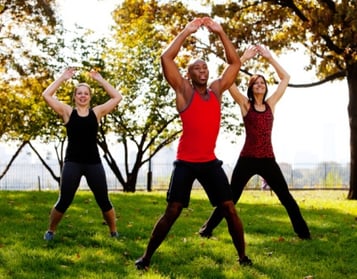Group exercise classes can be a good way to get in shape and have fun while at the gym. They are designed to allow participants to attend without prior experience. They offer a full warmup, full workout, and cool-down in a variety of settings and styles. However, sometimes trying a new class can be daunting or scary.

You may feel scared to try a new class because you feel inexperienced. You may believe that you can’t keep up with the “regulars.” In turn, these feelings can lead to you missing out on fun and exciting workouts. But I want you to know this: Any good instructor is prepared to teach all levels of participants. Not everybody in the class is at the same level. Some people may be new like you! So trust me when I say that you can try new classes, and you can get a great workout. You may leave the class feeling more confident. So give new group training classes a try to discover whether you like them, rather than never giving them a chance. Here are three classes that you can try now!
Of course, trying a new class is easier said than done. So here are some tips that you can use when you are trying a new group exercises class.
1. Read the Description
All gyms have descriptions of the group exercise classes. They are short summaries of the focus of the class. The difficulty level should also be noted in each description. However, most classes invite all levels to join. The location of the class, the time it starts, and the name of the instructor should also be stated. You can always ask a gym employee questions if you need more information.
2. Arrive Early
You do not have to arrive very early, but arriving about 5 to 10 minutes early will you give you plenty of time to locate the class. Most instructors arrive early as well, in order to advise participants on equipment needed. So being there before class starts gives you time to set up your equipment.
3. Introduce Yourself
As mentioned above, the name of the instructor should be included in the description of that class. Once you have located the class, find the instructor and introduce yourself. This is the time to inform the instructor that this is your first time participating and ask whether they have any advice or instructions for you. Instructors are always happy to help!
4. Find a Good Spot
Even though it is your first time attending, that doesn’t mean you have to be in the back. You want to find an area where you can see and hear the instructor. Even though the front is the perfect spot for that, the middle area will work just fine. You will be able to see and hear, but you won’t feel like you are on display for the rest of the class.
5. Start Slow
Most group exercise classes will have a warmup. During that time, get a feel for how hard you want to work. Since you are new to the class, start slow. The instructors will demonstrate different levels of work for each exercise. Level 1 may be a good place to start. Once you feel comfortable, you can then try to increase the intensity slowly throughout This will help you last longer as well as keep you safe from injury.
6. Have Fun!
The last thing for you to do to enjoy your workout is to have fun! Don’t worry about what others around you think. You are all there for the same reason, and that is to work out, feel good, and have fun.
If you are looking for more information about the group exercise classes offered here at NIFS, see our group fitness schedule. You can also download our free app, which provides the group exercise schedule as well.
This blog was written by Masie Duncan, Weight Loss Coordinator. To find out more about the NIFS bloggers, click here.










 No, I’m not going to fix your slice or tell you how to hit out of a bunker (I still can’t fix that myself). What I’m going to do is give you a few fitness tips that could potentially help add some yards off the tee or with long iron shots.
No, I’m not going to fix your slice or tell you how to hit out of a bunker (I still can’t fix that myself). What I’m going to do is give you a few fitness tips that could potentially help add some yards off the tee or with long iron shots.